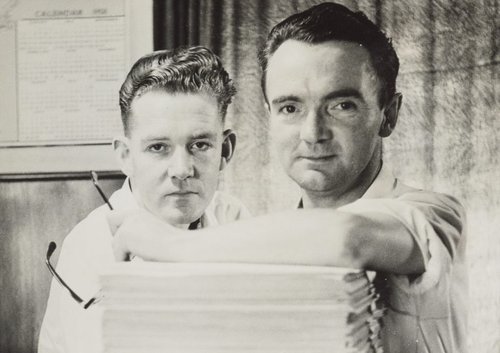
Morrow Productions created some of New Zealand’s most iconic commercials and short films. You might recall ‘Mr Dollar’ from the introduction of decimal currency in 1967.
Hailing from Glasgow, Bob was an experienced animator who had trained with Disney experts. After working for a few years in Wellington, he and Mike headed north and found a great place in Levin to start Morrow Productions. “It was a terrible house, but the large shed at the rear of the property was a big attraction,” said Morrow. Both buildings were largely gutted and fitted with almost everything they would need.
Tracy White, a Senior Documentation Archivist at Ngā Taonga Sound & Vision, is a big fan of Morrow Productions. “It was a very sophisticated animation studio. It had rooms for drawing and design, filming cels and background paintings and even a music studio.” The animations they produced had a wonderful, distinctive style – soft lines and curves with richly detailed backgrounds. However, using traditional drawing and painting techniques was very time consuming. One minute of 24 frames per second animation required 1,440 cels painted, photographed and moved.
Morrow were able to turn to the community for help. “Mike had been a Horowhenua College student. A local teacher from the college composed music scores and boys from Kohitere Boy’s Training Centre were also hired. They were trained from scratch to paint the cels,” says White.
Aside from some of the especially repetitive tasks, Morrow and Walker had a hand in everything. “They did it all: scripting, storyboarding, drawing, photographing, editing, synchronising image with sound. It was very hands on.”
Hero image: Mike Walker (left) and Bob Morrow of Morrow Productions.
'Mr. Dollar' - Made for the introduction of decimal currency (1966).
In addition to animation, they also used live action recordings. Local people from Levin were used for many of these. For a Gelven Baby Soap commercial Walker photographed over 70 babies to get the ideal look for the animation. During the 70s and 80s, Morrow created and co-produced several telefilms, including Mark II, Kingpin and Kingi’s Story, which dealt directly with the experiences of boys from Kohitere.
Ngā Taonga acquired the Morrow Productions archives in 2001. It includes their films, scripts, documentation and correspondence, as well as 24 boxes of animation cels. A real highlight is the scrapbook ‘The Story of Morrow Productions’. This tells the story of the company in its own words and through behind-the-scenes anecdotes, providing context for the work they created.
'New Zealand Apples' - Made for The New Zealand Apple & Pear Marketing Board (1961).
Some of Morrow’s finest work came with the increasing popularity of television in the 1960s. They created a whole range of commercials. Their ads for the Apple and Pear Board won awards in the United Kingdom. The series for the National Bank with Henry marrying a bank teller, was much loved. Perhaps their best known was Mr Dollar, who helped teach the nation about the arrival of decimal currency in 1967.
Henry and Mr Dollar are in Ngā Taonga Sound & Vision’s Sellebration online exhibition. Catch up or meet them for the first time alongside hundreds of commercials from the 1920s onwards. The exhibition shows the creative and imaginative ways advertisers have engaged with the New Zealand public. They remain an iconic part of the cultural landscape.
'Trees' - Made for the New Zealand Forest Service (1952).
In addition to the film and other documentation items in the Morrow Collection, there are also many press clippings. “These clippings provide a fantastic insight into their work,” says White. “Something like Papers Past is great, but only covers up to 1950. Between then and the computer era it can be difficult to find newspaper records. The specially curated and catalogued listings of the Ngā Taonga documentation collection are an invaluable resource for researchers.”
Contact us about Morrow Productions documentation.
A version of this article was originally published in Ōtaki Today.